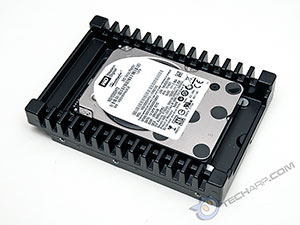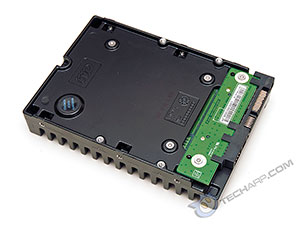Western Digital VelociRaptors
 |
 |
Western Digital may be marketing their new VelociRaptor family of high-speed hard drives as enterprise-class hard drives but they are also very popular with hardware enthusiasts who just cannot resist their 10,000 RPM spindle speed. Everything just seems much faster when you have a hard disk drive that spins at such a high speed.
To cater to this exclusive group of enthusiasts, Western Digital first introduced the Raptor and Raptor X hard drives with capacities of 36 GB to 150 GB. These Raptors evolved into the first-generation Western Digital VelociRaptor hard drives with twice the storage capacity in the much smaller 2.5" form factor.
Western Digital recently launched their third-generation VelociRaptor hard disk drive, which continues to be the world's only 10,000 RPM hard disk drive with a SATA interface. The third-generation VelociRaptor improved on its predecessor by using Advanced Format Technology (AFT) and higher-density platters to deliver not only 1 TB of storage capacity but also a sustained throughput of 200 MB/s. Take a look at its key features :
Ultra fast - Designed around a 10,000 RPM spin speed, these SATA 6 Gb/s drives include a 64 MB cache and deliver the ultimate in performance for photo and video editing.
Rock-solid reliability - With 1.4 million hours MTBF, these drives have the highest available reliability rating on a high capacity SATA drive.
Ultra-cool operation - Consumes less idle power and uses similar active power as the previous generation WD VelociRaptor, while offering higher capacity and performance.
Advanced Format (AF) - Technology adopted by WD and other drive manufacturers as one of multiple ways to continue growing hard drive capacities. AF is a more efficient media format that enables increased areal densities.
IcePack™ mounting frame - The 2.5-inch hard drive is enclosed in a backplane-ready 3.5-inch mounting frame with a built-in heat sink that keeps this powerful little drive extra cool when installed in high-performance desktop chassis.
NoTouch™ ramp load technology - The recording head never touches the disk media ensuring significantly less wear to the recording head and media as well as better drive protection in transit.
Pre-emptive Wear Leveling (PWL) - Ensures reliability for applications that perform a high incidence of read/write operations at the same physical location on the disk.
Rotary Acceleration Feed Forward (RAFF™) - Optimizes operation and performance when the drives are used in
vibration-prone, multi-drive chassis.
We did a short analysis of the drive earlier, but we are now able to produce a full review, after extensively testing this drive. Let's take a closer look!
Available Models
Currently, Western Digital offers three SKUs - the WD1000DHTZ (with a capacity of 1 TB), the WD5000HHTZ (with a capacity of 500 GB), and the WD2500HHTZ (with a capacity of 250 GB). Here's a summary of their physical differences :
|
WD1000DHTZ |
WD5000HHTZ |
WD2500HHTZ |
|
Formatted Capacity |
1,000 GB |
500 GB |
250 GB |
|
User Sectors |
1,953,525,168 |
976,773,168 |
488,397,168 |
|
No. Of Platters / Heads |
3 / 6 |
2 / 4 |
1 / 2 |
|
% Of Platter Used |
100 % |
75 % |
75 % |
The two smaller drives were obviously "sized" at 500 GB or 250 GB for marketing purposes. If Western Digital wanted to maximize storage capacities from their drives, they would offer storage capacities of 667 GB and 333 GB, but those numbers might not go down so well with the end-users. Hence, those two drives have a lot of spare capacity. Kinda wasted... Now, if only someone's smart enough to hack the firmware to access the rest!
Because hard disk drives are formatted from the outer tracks inwards, this undersizing of the 500 GB and 250 GB models will likely mean that these drives will only be accessing the faster outer segment of the platters, and therefore, perform better than the 1 TB model in some benchmark scenarios. They would also have better random access times. In a way, it is like this HDD modding method.
 |
Packaging
Like most OEM-packed hard drives, the WD VelociRaptor 1 TB hard disk drive came in just a sealed anti-static plastic packet with a sachet of dessicants to keep it dry.
All you need to do is just cut open the plastic packet and slide out the drive. Be sure to ground yourself before removing and handling the hard disk drive as static can damage it. In particular, you should try to avoid touching the exposed PCB located at the base of the drive.
Support Tech ARP!
If you like our work, you can help support out work by visiting our sponsors, participate in the Tech ARP Forums, or even donate to our fund. Any help you can render is greatly appreciated!
Page |
Topic |
|
1 |
||
2 |
||
3 |
• The WD VelociRaptor (WD1000DHTZ) |
|
4 |
||
5 |
• Testing The WD1000DHTZ |
|
6 |
||
7 |
||
8 |
||
9 |
||
10 |
||
11 |
<<< Western Digital WD1000DHTZ Overview : Previous Page | Next Page : The 1 TB WD VelociRaptor, Usable Capacity, Specification Comparison >>>







 Add to Reddit
Add to Reddit
